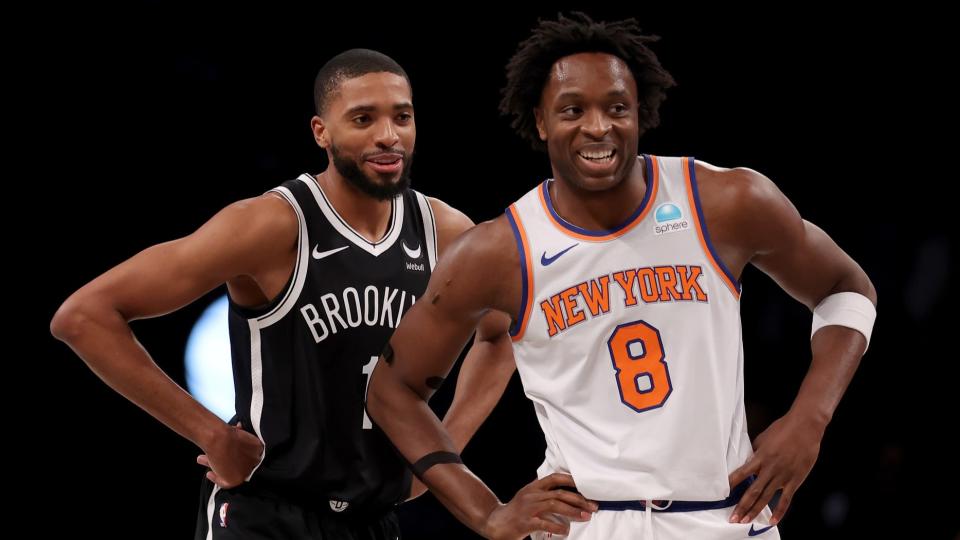Breaking down a potential Knicks trade for Mikal Bridges
The Knicks are one Boston Celtics win away from the official start of their offseason. This year, teams can talk to their own free agents on the day after the NBA Finals ends. So if the Celtics sweep the Dallas Mavericks, the Knicks can start negotiations with OG Anunoby, Isaiah Hartenstein, Precious Achiuwa, and their other free agents on Saturday. They can also start to negotiate extensions with Jalen Brunson and Julius Randle after the Finals ends.
Once again, New York enters the offseason well-positioned for a significant trade. The club has three picks in the top 38 of the 2024 NBA Draft, all of its future first-round picks, and the rights to three additional first-rounders.
If the Knicks want to upgrade their roster this offseason or down the line (they do), a trade is the most likely option. With that in mind, we took a look at the math behind a Mikal Bridges trade below (as unlikely as it is) and put together a few packages that would work under NBA trade guidelines with the help of Yossi Gozlan, who has a remarkably informative YouTube page if you want to learn more about teams' cap implications.
WOULD THE NETS EVER TRADE BRIDGES?
The short answer, in my opinion, is no. I think the answer will remain a "no" for as long as Sean Marks is Brooklyn’s top basketball decision-maker.
Recent history tells you Bridges will remain in Brooklyn for the foreseeable future: the Nets have consistently rebuffed teams interested in trading for Bridges. They’ve rejected offers with significant draft compensation (more than four first-round picks in at least one instance, per league sources). To be fair, we don’t know the value of those first-round picks (i.e.: protections on the picks, projections, etc.).
But the Nets have consistently rejected these offers, which is clear evidence that they want to build with Bridges. Also, why would Marks trade the best player he received in the Kevin Durant/Kyrie Irving trades?
A Bridges trade likely means another big rebuild. Would Marks at this point have the runway to execute a full-scale rebuild? I don’t see it. The Nets, who still prioritize re-signing free agent Nic Claxton, can probably slow-play the 2024-25 season. But they’ll need to be competitive again under Marks after the summer of 2025. They project to have significant cap space in that offseason.
So there is ample evidence that Brooklyn will keep Bridges for the foreseeable future. As a hypothetical, let’s say things go sideways for the Nets next season and they change course on Bridges. The Knicks should be able to put together a competitive offer for him. Would the Knicks and Nets actually execute a trade? It seems unlikely. But it’s helpful to take a look at the parameters of a potential Bridges deal because they also apply to other players making similar salaries.
BOGDANOVIC’S ROLE
Let’s start with Bojan Bogdanovic. His contract is currently guaranteed for $2 million. It becomes fully guaranteed at $19 million on June 28. If you’re thinking about a significant trade, the Knicks' decision on Bogdanovic is key.
Here’s Gozlan: "I think it makes sense to keep him and guarantee him for the upcoming season if the Knicks feel like there is a trade for an All-Star on the horizon. Attaching his $19 million with Julius Randle's $28.9 million allows them to match for just about anyone. If Bogdanovic is gone, they likely need to trade Josh Hart or Mitchell Robinson, or even try to get Precious Achiuwa involved in a sign-and-trade to get enough money to send out."

MAKING SALARIES MATCH?
If the Knicks re-sign Anunoby and Hartenstein and keep Bogdanovic, they will probably be over the first apron for 2024-25 ($178 million). In this scenario, they’d need to send out more money in a trade for Bridges than they take back.
Trading Randle's $28.9 million (and draft compensation) for Bridges' $23.3 million is the easiest way to make a trade work next season, no matter the Knicks' apron situation.
If the Knicks decided to waive Bogdanovic and re-sign Anunoby and Hartenstein, they would probably end up under the first apron. In that scenario, the Knicks could take back more salary than they are sending out in a trade.
Here’s Gozlan: "If done on (or after) July 1, the Knicks would only need to get within $7,775,000 of Bridges' $23.3 million salary. So they’d need to send out $15.5 million. A combination of Mitchell Robinson and one of their minimum players like Daquan Jeffries, Mamadi Diakite, or Jericho Sims (and draft compensation) would work."
This trade would hard-cap the Knicks at the first apron in 2024-25. It would also likely require a third team to acquire Robinson because Brooklyn will presumably have Claxton at center.
The Knicks could make the math work on a Bridges trade if they sent out a package centered around Bogdanovic and draft compensation.
They could send out Bogdanovic, draft compensation and an additional $4.3 million to satisfy NBA trade rules. The Knicks could get there by including Jeffries' $2.5 million and Sims' $2.1 million.
Here’s Gozlan: "(In the Bogdanovic scenario), the Knicks would be hard capped to the second apron. But it should be possible to field a roster below (the second apron) featuring (Jalen) Brunson, Randle, Anunoby, Bridges, (Josh) Hart, Donte (DiVincenzo), Hartenstein, Mitchell (Robinson) and (Miles) McBride.”
Of course, draft compensation is a key to any deal for Bridges.
The Knicks will be able to trade a maximum of seven first-round picks at the 2025 trade deadline (2025, 2027, 2029, 2031, and the firsts owed by Milwaukee, Detroit, and Washington).
Again, as unlikely as it is, the math around a Bridges trade is instructive because it applies to other players making similar salaries. Players like Kyle Kuzma, Andrew Wiggins, and Bruce Brown are within proximity of Bridges’ salary in 2024-25.

